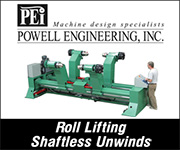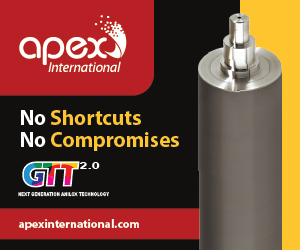Featured Stories
-
Elevating Pouch Manufacturing with Pearl Technologies' Cutting-Edge Solutions
For manufacturers seeking efficiency, precision, and safety in pouch production, Pearl delivers unmatched innovation across three standout... -
Faster Product Composition Analysis Equals Better Quality Assurance
Near Instant Testing and Reduced Costs to be Found -
Methods to Precisely Measure Tension and Web Control
How to Control Automatically Within Set Parameters
News | New Products
-
PACKZ 11 Launches with Industry-First RIP Integration
Plus extended CF2 format and automated support for 2-D Barcodes as Required by the Sunrise 2027 Initiative
-
Double E Group Acquires CAC, Further Enhancing its Strength in the Global Converting Industry
Double E Group, a global leader in converting components and web handling technology, has announced its acquisition of Converter Accessory Corporation (CAC)
-
Nobelus Launches Entry-Level Komfi® Thermal Laminator
FINISHING SOLUTIONS SUPPLIER OFFERS NEW JUNIOR 52 LAMINATING SYSTEM
-
Double E Group Mourns the Loss of Founder and Converting Industry Pioneer, Richard Edward Flagg
Double E Group announces with profound sadness the passing of its founder, Richard Edward “Ed” Flagg, on June 23, 2025. He was 85.
-
Convertech Brand to Fully Transition to Double E Group Same Team, Same Excellence, Unified Name
Double E Group has announced that Convertech, one of its subsidiaries and a trusted provider of core chucks and shaft solutions for the converting industry, will now operate solely under the Double E Group brand.
-
Pulse is Making Print Simple at Labelexpo Europe 2025
Narrow web ink specialist Pulse is Making Print Simple at Labelexpo Europe 2025, as it challenges flexo printers to rethink how they work and shows solutions that turn production bottlenecks into revenue generators.
-
ROTOCON to debut at Labelexpo Europe with three machine demonstrations
ROTOCON will make its Labelexpo Europe debut, exhibiting together with HS Machinery on stand 4D21.
Expert Advice
Permanent & Removable Pressure-Sensitive Adhesives
- Published: August 01, 2003, By David J. Bentley Jr., RBS Technologies
An intriguing aspect of pressure-sensitive adhesives is the wide variety available. They come in different forms for application as solutions in solvent, as dispersions or emulsions in water, and as 100% solids materials such as hot melt adhesives. They can use various polymers such as rubbers, acrylates, etc., to give them different performance characteristics. They might have high tack or low tack. They can provide high cohesive strength with low adhesive strength or low cohesive strength with high adhesive strength.
Another interesting characteristic is they can be permanent or removable. This is perhaps a feature of pressure-sensitive adhesives that not only contributes to their versatility but also complicates their use. A permanent pressure-sensitive adhesive destroys the substrate with attempts to remove it. A typical application is a label indicating the selling price for an item. A removable pressure-sensitive adhesive removes cleanly from the substrate. An example is a name tag applied at a party for identification.
Most people in the converting industry know suppliers offer both types of products. The manufacturer selects different ingredients to make the adhesive aggressive or non-aggressive.
Another factor that is less appreciated but equally important in the manufacture of a product using a pressure-sensitive adhesive is the substrate being used.
A permanent pressure-sensitive adhesive relies on poor internal strength of the substrate to which it is applied. As expected, a removable pressure-sensitive adhesive requires good internal strength of the substrate.
Hidden between the two previous statements is the fact that a product sold as a permanent pressure-sensitive actually could be a removable product depending on the substrate being used and vice versa.
Consider an example: A converter purchases a product labeled as a permanent pressure-sensitive adhesive and coats it onto papers for use as labels. When the labels are adhered to something, the aggressive nature of the adhesive is stronger than the internal strength of the paper. Attempts at removal therefore result in tearing of the paper. By definition, this is a permanent pressure-sensitive adhesive.
Suppose the same pressure-sensitive adhesive was coated onto a rather thick polyester film and made into labels. After application of these labels onto something, a person probably could remove them because of the high internal strength of the polyester film. The so-called permanent adhesive now is removable.
Likewise, a removable adhesive on high-internal-strength paper will deliver a product more removable than the same adhesive applied on a low-internal-strength paper. In other words, relying on the manufacturer's definition that pressure-sensitive adhesives are removable or permanent can be somewhat misleading. No pressure-sensitive adhesive truly is removable or permanent in its own right. Rather, a finished product using a pressure-sensitive adhesive applied onto a substrate can be removable or permanent.
The difference is the degree of permanence or ability for removal depend on two factors: the aggressiveness of the adhesive and the internal strength of the substrate to which it is applied. The adhesive manufacturer controls the first factor, but the converter making the label or other pressure-sensitive product controls the second.
Knowing both factors are important components of a finished pressure-sensitive product is necessary to ensure any product labeled permanent or removable will perform as advertised.
David J. Bentley Jr. is a recognized industry expert in polymers, laminations, and coatings with more than 30 years of experience in R&D and technical service. Contact him at dbentley@unm.edu.





















